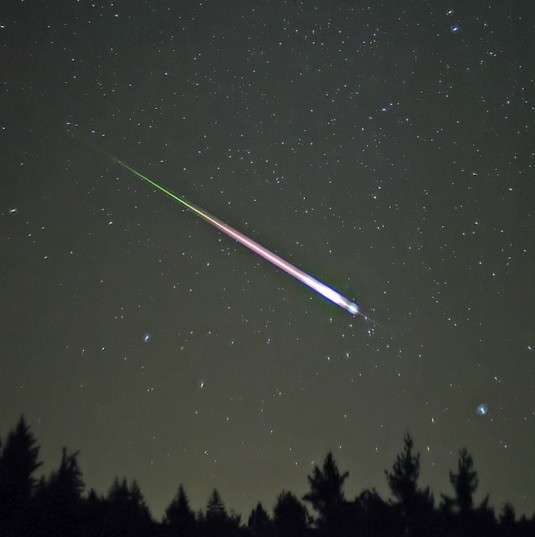How to Watch Dazzling Leonid Meteor Shower Peak This Week
| Ana Verayo | | Nov 16, 2015 06:03 AM EST |
(Photo : Wikipedia) The Leonid meteor shower will peak during Tuesday and Wednesday morning this week.
This week, stargazers and everyone alike will be treated to the Leonid meteor shower, which only happens every middle of November during the year. The night skies will be filled with a dazzling array of shooting stars, so watch out for Tuesday night until Wednesday night.
Like Us on Facebook
The Leonids will be appearing in the eastern night sky near the constellation of Leo or The Lion where the meteors will be visible across the skies. According to Astronomy Magazine, a range of up to dozens of meteors can be experienced every hour during its peak, however, the Leonids are pretty fast moving, where they enter the Earth's atmosphere at incredible speeds of 158,000 miles per hour, which is considered to be the fastest moving meteor shower.
Typically, the best time to watch any meteor shower is after midnight and into the wee hours of the morning until dawn, where the Leonids are no exception to this. NASA also advises that the waning crescent moon will soon disappear, making the Leonids shine brighter than ever.
The best show will be the during the peak hours of Leonids, specifically the mornings of November 17 and 18. If this time is too early for some stargazers, sunset is also a good time where the eastern skies is the place to start, in between the middle of the skies and bottom one third of it. The moon will set at around 10 P.M. local time where around 2 A.M., becomes the best time to look overhead. After 2 A.M. stargazers should be able to set their viewing halfway up in the western region of the skies.
In order to see the brightest meteors, the ideal place would be away from light pollution especially city lights. As the eyes adapt to the darkness in about 10 minutes, the eyes will experience better vision during the night after 45 minutes which means that the shooting stars will become brighter and more obvious as the darkness continues into the night.
Meteors are actually tiny, pea or sand type of debris that is falling from a comet's tail, as Earth's orbit moves into the comet's path. For the Leonids, the debris originates from the Tempel-Tuttle comet where they enter the planet's atmosphere, burning up and transforming into dazzling "falling stars".
TagsHow to Watch Dazzling Leonid Meteor Shower Peak This Week, Leonid meteor shower, watch meteor shower this week, watch leonid meteor shower, leonids, best time to watch leonids, best time to watch leonid meteor shower, leonid meteor shower peak, leonid meatoer shower peak, shooting stars, meteors, meteor shower, falling stars, leonid meteor shower 2015, best meteor shower, november 17 and 18 leonid meteor shower peak
©2015 Chinatopix All rights reserved. Do not reproduce without permission
EDITOR'S PICKS
-

Did the Trump administration just announce plans for a trade war with ‘hostile’ China and Russia?
-

US Senate passes Taiwan travel bill slammed by China
-

As Yan Sihong’s family grieves, here are other Chinese students who went missing abroad. Some have never been found
-

Beijing blasts Western critics who ‘smear China’ with the term sharp power
-

China Envoy Seeks to Defuse Tensions With U.S. as a Trade War Brews
-

Singapore's Deputy PM Provides Bitcoin Vote of Confidence Amid China's Blanket Bans
-

China warns investors over risks in overseas virtual currency trading
-

Chinese government most trustworthy: survey
-

Kashima Antlers On Course For Back-To-Back Titles
MOST POPULAR
LATEST NEWS
Zhou Yongkang: China's Former Security Chief Sentenced to Life in Prison

China's former Chief of the Ministry of Public Security, Zhou Yongkang, has been given a life sentence after he was found guilty of abusing his office, bribery and deliberately ... Full Article
TRENDING STORY

China Pork Prices Expected to Stabilize As The Supplies Recover

Elephone P9000 Smartphone is now on Sale on Amazon India

There's a Big Chance Cliffhangers Won't Still Be Resolved When Grey's Anatomy Season 13 Returns

Supreme Court Ruled on Samsung vs Apple Dispute for Patent Infringement

Microsoft Surface Pro 5 Rumors and Release Date: What is the Latest?










